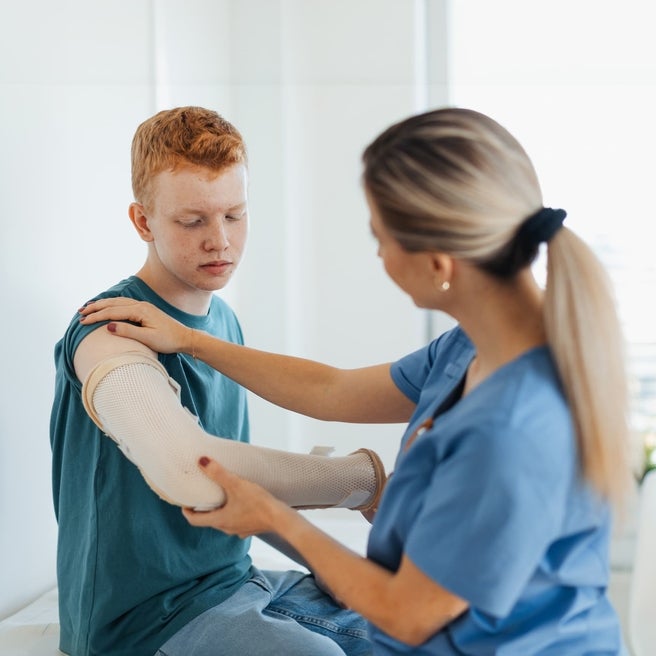What is a stress fracture?
Bone stress fractures are small cracks or injuries to a bone caused by repetitive activity such as jumping or running. Often called "overuse injuries," stress fractures tend to occur at the junction of bones, muscles and tendons and are common in the foot and ankle.
What is a bone stress injury?
Bone stress injuries (BSI) encompass all types of stress injuries, ranging from a mild stress response such as shin splints, to a full bone stress fracture.
Physical stress is important for musculoskeletal tissues to grow and develop. Children and adults become fit by adapting to graduated stresses. However, overuse injuries are caused by repeated stress – sometimes called microtraumas – that exceeds the body's ability to adapt and repair itself.
Repetitive force to bones, joints and tendons can lead to stress reactions like pain and swelling. This stress can decrease the health of the bone. If the body is not given time to rest and recover from these stress reactions, bone stress injuries often worsen, creating cracks or fractures in the bones. The bones of children and teens are especially vulnerable to stress fractures because their bones are still growing.
What causes stress fractures and bone stress injuries?
Bone stress fractures or bone stress injuries may be caused by initial increased activity or by repetitive activity in an elite year-round athlete. These types of injuries are found more frequently in younger children as competitive sports increase their training demands and many youth athletes are competing year-round.
Bone stress injuries typically occur over a course of days to weeks. The location of stress injuries or stress fractures can vary depending on the part of the body most frequently overstressed. For example, dancers often experience stress fractures in their feet (most commonly the second metatarsal) or ankles, gymnasts at their wrists, pitchers in their arms or shoulders, and soccer players in their legs, knees, or ankles. Bone stress injuries can occur in many other areas of the body, including the spine, sesamoids (in the knee, thumb or big toe) and shins (tibia).
Bone stress injuries differ from traumatic fractures, in which a significant amount of force is applied to the bone suddenly (e.g., a collision with another person or hard object). However, bone stress fractures/stress injuries in youth should be taken seriously and assessed by orthopedic specialists who have advanced training in growing bones and treatments that will offer youth the best opportunity to return to an active lifestyle.
Signs and symptoms of bone stress injuries
Bone stress fractures and other stress injuries can produce pain, tenderness and swelling. While symptoms may come and go during activity and rest, they tend to worsen over time and begin to have pain even when not participating in activity. Depending on the location of the injury, your child may demonstrate outward cues of their injury such as limping.
In most cases, your child can tell you where the pain or discomfort is comes from (e.g., right shin or left ankle), but may not recall how or when the area was injured.
If your child's pain becomes severe or continues even when they are resting, contact your child's physician or an orthopedic specialist for an assessment.
Treatments for stress fractures and stress injuries in children
At Children's Hospital of Philadelphia (CHOP), bone stress fractures and stress injuries in children and teens are treated by orthopedic and sports medicine physicians who specialize in diagnosing and treating bone and muscle injuries in children, teens and young adults.
Our expert physicians will examine your child, assess their pain, learn about your child's medical history and perform diagnostic imaging — such as X-rays, MRIs and/or bone scans — to diagnose the problem.
Then, we will work with you and your child to develop an individualized treatment plan to address the current fracture or injury and develop a prevention program to avoid future stress injuries.
To create a customized treatment and prevention plan for your child, we:
- Evaluate their current training and competition activities. For example, factors like improper technique, poor fitting shoes, inadequate rest and other external factors may be contributing to their bone stress injuries.
- Examine factors specific to the patient, such as the shape of the foot (flat feet or high arch), strength imbalances, or flexibility limitations that can contribute to bone stress injuries
- Examine their typical diet and nutritional needs and if this is contributing to their stress injury
- Assess their hormonal levels, vitamin levels and growth factors, as indicated
- Determine how social or peer factors may play a role in their recovery or reinjury
Then, we will develop a customized program of rehabilitation exercises for each individual patient. Treatments for bone stress injuries generally include conservative therapies such as wearing a boot, cast or brace, icing, rest and physical therapy. In rare cases, surgical intervention may be recommended to support the bones.
Our orthopedic and sports medicine physicians, advanced practice providers and physical therapists also work with area coaches to ensure young athletes receive training about how to optimize their skills, while also protecting their bodies.

Why choose CHOP
We have more specially trained sports medicine physicians, orthopedic surgeons, physical therapists and athletic trainers than any other pediatric orthopedic facility in the region.
Resources to help
Sports Medicine and Performance Center Resources
We have created resources—including patient and family educational materials, videos, and more—to help you find answers to your questions and feel confident about the care you are providing your child.
